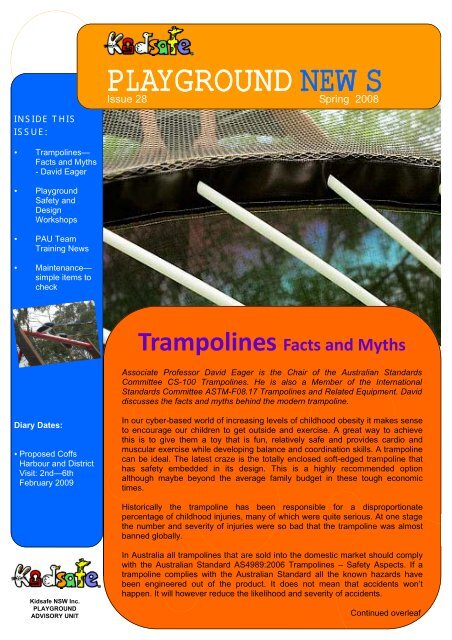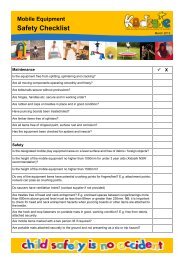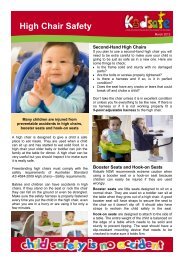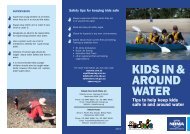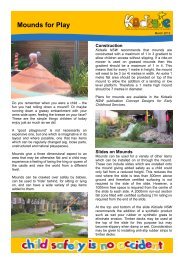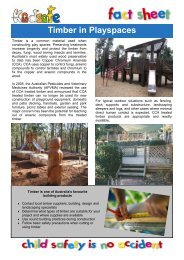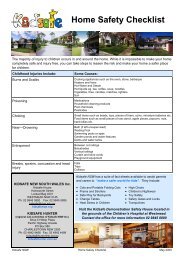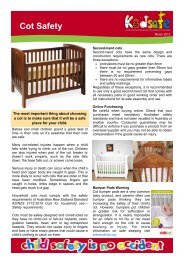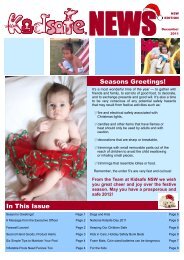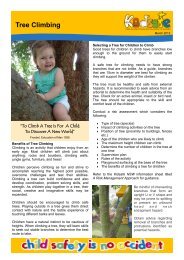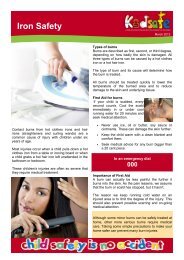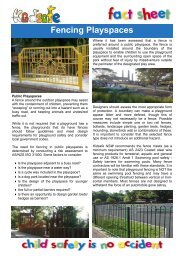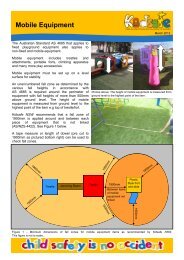article - Kidsafe NSW
article - Kidsafe NSW
article - Kidsafe NSW
Create successful ePaper yourself
Turn your PDF publications into a flip-book with our unique Google optimized e-Paper software.
PLAYGROUND NEWS<br />
Issue 28 Spring 2008<br />
INSIDE THIS<br />
ISSUE:<br />
• Trampolines—<br />
Facts and Myths<br />
- David Eager<br />
• Playground<br />
Safety and<br />
Design<br />
Workshops<br />
• PAU Team<br />
Training News<br />
• Maintenance—<br />
simple items to<br />
check<br />
Trampolines Facts and Myths<br />
Associate Professor David Eager is the Chair of the Australian Standards<br />
Committee CS-100 Trampolines. He is also a Member of the International<br />
Standards Committee ASTM-F08.17 Trampolines and Related Equipment. David<br />
discusses the facts and myths behind the modern trampoline.<br />
Diary Dates:<br />
• Proposed Coffs<br />
Harbour and District<br />
Visit: 2nd—6th<br />
February 2009<br />
In our cyber-based world of increasing levels of childhood obesity it makes sense<br />
to encourage our children to get outside and exercise. A great way to achieve<br />
this is to give them a toy that is fun, relatively safe and provides cardio and<br />
muscular exercise while developing balance and coordination skills. A trampoline<br />
can be ideal. The latest craze is the totally enclosed soft-edged trampoline that<br />
has safety embedded in its design. This is a highly recommended option<br />
although maybe beyond the average family budget in these tough economic<br />
times.<br />
Historically the trampoline has been responsible for a disproportionate<br />
percentage of childhood injuries, many of which were quite serious. At one stage<br />
the number and severity of injuries were so bad that the trampoline was almost<br />
banned globally.<br />
<strong>Kidsafe</strong> <strong>NSW</strong> Inc.<br />
PLAYGROUND<br />
ADVISORY UNIT<br />
In Australia all trampolines that are sold into the domestic market should comply<br />
with the Australian Standard AS4989:2006 Trampolines – Safety Aspects. If a<br />
trampoline complies with the Australian Standard all the known hazards have<br />
been engineered out of the product. It does not mean that accidents won’t<br />
happen. It will however reduce the likelihood and severity of accidents.<br />
Continued overleaf
Trampolines—Facts and Myths continued<br />
What to look for when purchasing a trampoline?<br />
Step 1—Compliance: The most important and easiest<br />
thing to look for is a statement of compliance with the<br />
Australian Standard AS4989:2006 Trampolines – Safety<br />
Aspects. For a trampoline to comply it must have been<br />
tested for compliance and have appropriately marked<br />
packaging, point-of-purchasing displays, and include<br />
promotional safety literature.<br />
Watch out for overseas compliance statements that can<br />
not be verified. When in doubt seek advice from the<br />
<strong>NSW</strong> Office of Fair Trading.<br />
The most important physical aspect for compliance with<br />
the Standard is that the trampoline frame limits the<br />
maximum impact that a child can sustain and prevents<br />
limbs from entanglement, that is, the suspension system<br />
must be designed to protect the child from injury.<br />
In Australia all trampolines that are sold should<br />
comply with the Australian Standard<br />
AS4989:2006 Trampolines – Safety Aspects.<br />
This is achieved by the use of a ‘frame padding system’,<br />
or for other designs where the springs are beneath the<br />
trampoline bed, by a ‘soft-edge system’. The trampoline<br />
design must still absorb the impact without the<br />
net-enclosure attached, even though it may be supplied<br />
with a net!<br />
Watch out for trampolines that are supplied with inferior<br />
padding as this will quickly deteriorate and not provide<br />
adequate protection for your child. A really quick check<br />
is to squeeze the foam padding. If it makes popping<br />
sounds like when you pop bubble wrap, do not purchase<br />
this trampoline. If you squeeze the foam padding as<br />
hard as you can and your thumb and index finger can<br />
still feel uncompressed form between your fingers, you<br />
can be assured that your child’s head and spine will be<br />
afforded an adequate level of impact protection.<br />
Step 2—Installation: Ensure that the trampoline is<br />
correctly installed. Always install on a flat, level surface<br />
that has some form of impact attenuation such as grass<br />
or bark. This also applies to enclosed trampolines.<br />
Place the trampoline away from walls, structures,<br />
fences, sharp hard objects, and other play structures.<br />
The Standard recommends 2.5 metres clearance zone<br />
for open trampolines and 1.5 metres for enclosed<br />
trampolines.<br />
Adequate overhead clearance is essential. Never install<br />
your trampoline beneath power lines, clothes lines or<br />
any other object. Watch out for situations that may<br />
change with time such as trees growing into the jumping<br />
space. Don’t install the trampoline above concrete.<br />
Never use the area beneath the trampoline as a storage<br />
area for garden tools and other <strong>article</strong>s. Do not allow<br />
children to park their tricycles or other toys beneath the<br />
bed or within the clearance zones.<br />
Step 3 - Supervision: Misuse and abuse of the<br />
trampoline is dangerous and can cause serious<br />
injuries. The basic rules are:<br />
• One user at a time<br />
• Do not use the trampoline with the family dog or<br />
cat<br />
• Do not allow the user to jump from the trampoline<br />
to the floor or ground when dismounting, or onto<br />
the trampoline when mounting<br />
• Never allow the user to jump onto the trampoline<br />
from the roof or other high launching platforms<br />
• Do not allow hard objects such as skate boards,<br />
surf boards, bicycles, or roller skates on to the<br />
trampoline<br />
• Hard buckles, jewellery or backpacks should not<br />
be worn and it is best to discourage wearing of<br />
shoes while bouncing on the trampoline<br />
TYPES OF TRAMPOLINES<br />
Inground trampolines are inherently safer than<br />
un-netted aboveground trampolines as they reduce the<br />
fall height from the trampoline to the ground. They are<br />
ideal for children with limited mobility as this<br />
configuration allows the carer to more easily transfer<br />
the child onto the trampoline bed.<br />
Consideration must be given to drainage and access<br />
for maintenance.<br />
For smaller, bouncing-type devices that are used in<br />
Family Day Care and Early Childhood settings, these<br />
trampolines must be designed, built and sold with all<br />
the safety features and documentation required by the<br />
Standard. This means that the suspension system<br />
must be designed in such a way as to prevent little legs<br />
penetrating between the frame, bed and springs.<br />
The fall heights from these smaller trampolines is<br />
considerably less but it is still important to check<br />
location and free space provisions. As they are a<br />
forced movement device that is less than 500 mm<br />
above ground level, there is no requirement to install/<br />
use over certified undersurfacing. It is recommended<br />
however, that they be installed/used over an impact<br />
attenuating surface (or soft surface) such as grass or<br />
bark mulch with clearance zones of 1.5 metres.<br />
Please refer to the <strong>Kidsafe</strong> <strong>NSW</strong> fact sheets titled<br />
Trampolines and Safe Fall Zones<br />
available on the website.<br />
kidsafensw.org
PLAYGROUND SAFETY AND DESIGN WORKSHOPS<br />
In recent months, <strong>Kidsafe</strong> <strong>NSW</strong> has held a series of<br />
Playground Safety and Design workshops.<br />
The session held at West Ryde in September was<br />
attended by a variety of organisations including<br />
representatives from local government, children’s<br />
services, landscape designers, education and<br />
equipment suppliers.<br />
Gosford Council hosted a workshop in October for<br />
staff of their Children’s Services.<br />
November workshops hosted by Palerang Council and<br />
Conargo Shire Council were attended by<br />
representatives from over 8 local government areas.<br />
Delegates were provided with information on<br />
playground standards, basic training in conducting<br />
inspections and maintenance checks and design ideas<br />
for future planning.<br />
<strong>Kidsafe</strong> <strong>NSW</strong> has received many requests for training<br />
particularly in regional areas and planning has<br />
commenced for a series of workshops throughout<br />
<strong>NSW</strong> in 2009. If you are interested in attending or<br />
hosting a workshop, please call 02 9845 0890 or email<br />
kidsafe@chw.edu.au to register your expression of<br />
interest.<br />
The Playground Safety and Design Workshop provides the prerequisite knowledge for<br />
enrolment in the University of Technology Sydney<br />
Level 2 Operational Playground Inspectors Course.<br />
MAINTENANCE<br />
A regular maintenance regime is an essential part in keeping the<br />
backyard safe.<br />
Check all play items for spiders and insects<br />
Check all play items are securely anchored<br />
Check the condition of all play items for splinters, rust, detachments or<br />
weakening from exposure to the sun<br />
Rake undersurfacing material and maintain to a depth of 250mm<br />
Check sandpits for animal contamination<br />
Check all chains (eg. swings) for rust, wear and tear<br />
Taken from the <strong>Kidsafe</strong> <strong>NSW</strong> Fact Sheet “Safe Play for Backyards”
This Issue of “Playground News” is proudly sponsored by The Garden Makers<br />
WOULD YOU LIKE TO<br />
SPONSOR<br />
PLAYGROUND NEWS?<br />
• The Playground News would not happen if it were not<br />
for the quarterly sponsors. <strong>Kidsafe</strong> <strong>NSW</strong> seeks to<br />
recover printing and postage costs for Playground<br />
News each quarter.<br />
• Sponsorship of Playground News indicates your<br />
support of the philosophy and services of the<br />
Playground Advisory Unit, <strong>Kidsafe</strong> <strong>NSW</strong>.<br />
• Playground News is distributed directly to the<br />
playground industry, children’s services, community<br />
health providers, local government, government<br />
departments, schools, landscapers and designers.<br />
• Sponsors are offered the opportunity to submit an<br />
<strong>article</strong> on a topic of their choice and specialisation.<br />
Call Kay Lockhart on 02 9845 0890 if you<br />
would like to sponsor a future issue.<br />
Do you have a story or <strong>article</strong> you would<br />
like to share with us? We invite you to<br />
send in <strong>article</strong>s that may interest our<br />
readers.<br />
KIDSAFE <strong>NSW</strong> PLAYGROUND ADVISORY UNIT<br />
Training for the Playground Advisory Unit Team<br />
In recent months the Playground Advisory Unit Team has undergone training to further enhance the services<br />
provided by the <strong>Kidsafe</strong> <strong>NSW</strong> Playground Advisory Unit (PAU).<br />
Kay Lockhart completed the Level 2 Playground Inspector (Operational) Inspection and Maintenance course. This<br />
course enabled Kay to extend her experience and knowledge and provided a valuable opportunity to engage and<br />
network with other stakeholders passionate about safe playspaces and the safety of children.<br />
Kate Fraser and Bev Boland completed the Level 3 Outdoor Playground Inspector (Comprehensive) Inspection and<br />
Maintenance.<br />
Both courses were conducted by Dr David Eager (Associate<br />
Professor in the Faculty of Engineering, University of Technology,<br />
Sydney). Many thanks to David Eager and his associate Jim Connor<br />
for supporting <strong>Kidsafe</strong> <strong>NSW</strong> .<br />
C/O The Children’s Hospital at Westmead<br />
Locked Bag 4001<br />
Westmead <strong>NSW</strong> 2145<br />
Phone: 02 9845 0890<br />
Fax: 02 9845 0895<br />
Email: kidsafe@chw.edu.au<br />
Website: kidsafensw.org<br />
Services provided by the PAU include:<br />
Phone Advisory Service<br />
Onsite Inspections Services<br />
Playground Safety Audits<br />
Evaluation of Playspace Plans<br />
Design Advice<br />
Playground Safety and Design<br />
Workshops<br />
Fact Sheets<br />
Publications including:<br />
• Resource Directory<br />
• Concept Designs<br />
• Plants for Playspaces<br />
• Plan It Guidelines


